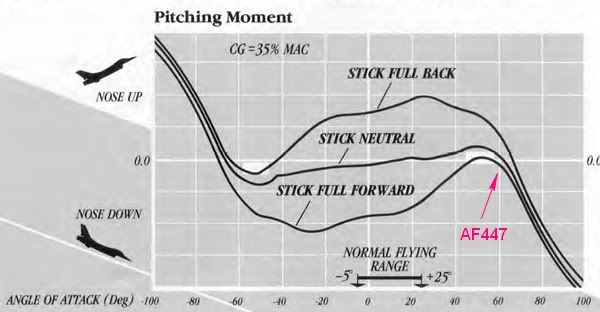As most here know, it is not my style to "correct" someone or tell them "they are stuck on stupid" or challenge their lineage. I prefer to iterate my point with data and my anecdotal evidence, experience, if you prefer. Hence...
a) To one poster challenging an estimate of AoA using known pitch /roll attitude and platform inertial velocities at impact:
Good math, poor aeronautics :-
I am completely familiar with the fact that planes fly thru the airmass, which may be moving with respect to the surface, even a "moving' surface such as the sea, with its currents. Ditto for airmasses moving vertically, as in storms or mountain waves or thermals.
So assuming a reasonable airmass movement within a few hundred feet above the ocean, as well as the current, a few knots here and there are not significant.
Cogsim points out BEA's finding of the horizontal and vertical components of the jet at impact ( last recorded value). Further, BEA claims a pitch attitude of 16 deg or so and 5 deg roll to the left.
If we do the math we see an approx 45 degree descent angle with nose up at 16 degrees. So my estimate is about 60 - 61 degrees AoA with respect to the longitudinal axis of the jet. Actual AoA seen by the wing is prolly a bit different due to the incidence angle of the wing, but close enuf for estimates.
So I return to my graphic of another jet's pitch moment characteristics.

It is quite possible that the 'bus has a similar aero behavior with respect to static stability ( not dynamic or phugoid or .....). So I simply show that the jet could have been in a stabilized deep stall with little or no capability to get the nose down ( call it pitch authority) , regardless of pilot input. Especially with the THS trimmed almost to the max.
A small roll at impact seems logical, especially if the 'bus has great lateral stability or the computers still have some degree of authority in yaw.
b) The skydiver analogy seems close, but realize the later inertials and GPS units are very capable of measuring tiny velocities. The inertials in all three axis, the GPS much better horizontally than vertically ( it's why JDAM quits using GPS several thousand feet above the tgt and prefers a near vertical vector). Further, skydivers DO HAVE A L/D. It ain't much, heh heh, but can be measured if you carry one with you on your next jump.
respectfully,
Gums sends....